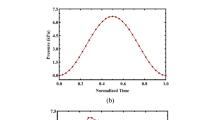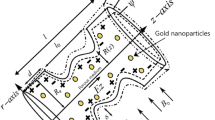Summary
The aim of this study was to provide detailed data on velocity profile development in the normal porcine main pulmonary artery and its main branches. Under spontaneous hemodynamic conditions in twelve open-chest 90kg pigs, perivascular pulsed Doppler ultrasound was used for blood velocity measurements in the entire cross-sectional area in three axial locations in the main pulmonary artery and along one diameter in the main branches. Computerized threedimensional visualizations of the spatial and temporal development of velocity profiles were made throughout the heart cycle. The results were similar one and two diameters downstream of the pulmonary valve. In the early systolic acceleration phase, the velocity profile became skewed, with the highest velocities (132.7 ± 19.4cm · sec−1) towards the inferior to right superior vessel wall, and rotated counterclockwise 45°–90° during the late acceleration to early deceleration phase in 9 out of 11 pigs. Maximum retrograde velocities (31.4 ± 14.9cm · sec−1) were observed at the inferior to the right superior vessel wall in the late systolic deceleration phase and in early diastole. During diastole, low retrograde to insignificant antegrade velocities were observed. Immediately upstream of the pulmonary bifurcation, the velocity profile disclosed two peaks at locations corresponding to the two main branches. A confined area with retrograde velocities was seen at the right vessel wall in late systole. Low-scale antegrade velocities were observed throughout diastole in the entire cross-sectional area. In the left main branch, the velocity profiles were found to be somewhat skewed towards the left vessel wall, corresponding to the smaller curvature of the left main branch, while the velocity profile in the right main branch was skewed against the superior vessel wall throughout systole. This study thus disclosed that the blood velocity profiles in the main pulmonary artery system were skewed and that mean velocity varied 26%–50% between measuring points, exhibiting an as yet unexplained rotational phenomenon. The skewed velocity profile in the porcine pulmonary trunk indicates that single-point blood velocity measurements can only serve as a basis for cardiac output estimations when used with considerable caution.
Similar content being viewed by others
References
Fry DL (1968) Acute vascular endothelial changes associated with increased blood velocity gradients. Circ Res 22:165–197
Stein PD, Walburn FJ, Sabbah HN (1982) Turbulent stresses in the region of aortic and pulmonary valves. J Biomech Eng 104:238–244
Moore GM, Smith RRL, Hutchins GM (1982) Pulmonary artery atherosclerosis. Arch Pathol Lab Med 106:378–380
Yoganathan AP, Ball J, Woo Y-R, Philpot EF, Sung H-W (1986) Steady flow velocity measurements in a pulmonary model with varying degrees of pulmonic stenosis. J Biomech 19:129–146
Godfrey SG (1990) An overview of Atherosclerosis: A Look to the Future. Toxicol Pathol 18(4):623–635
Goldberg SJ, Sahn DJ, Allen HD, Valdes-Cruz LM, Hoenecke H, Carnahan Y. (1982) Evaluation of pulmonary and systemic blood flow by two-dimensional Doppler echocardiography using fast Fourier transform spectral analysis. J Am Coll Cardiol 50:1394–1400
Sanders SP, Yeager S, Williams RG. (1983) Measurement of systemic and pulmonary blood flow and Qp/Qs ratio using Doppler and two-dimensional echocardiography. J Am Coll Cardiol 51:952–956
Valdes-Cruz LM, Mesel E, Sahn DJ, Fisher DC, Larson D. (1984) A pulsed Doppler echocardiographic method for calculating pulmonary and systemic blood flow in arterial level shunts: Validation studies in animals and the initial human experience. Circulation 60:355–359
Kitabatake A, Inoue M, Asao M, Ito H, Masuyuama, Tanouchi J, Morita T, Hori M, Yoshima H, Abe H. (1984) Non-invasive evaluation of the ratio of pulmonary to systemic flow in atrial septal defect by duplex echocardiography. Circulation 69:73–79
Savino JS, Troianos CA, Aukburg S, Weiss R, Reichek N (1991) Measurement of pulmonary blood flow with transesophageal two-dimensional and Doppler echocardiography. Anesthesiology 75:445–451
Paulsen PK, Andersen M (1981) Continuous registration of blood velocity and cardiac output with a hot-film anemometer probe, mounted on a Swan-Ganz thermodilution catheter. Eur Surg Res 13:376–386
Hasenkam JM, Østergaard JH, Pedersen EM, Paulsen PK, Nissen T (1986) Continuous registration of cardiac output with a new computer system designed for hot-film anemometry: An in vitro study. Life Supp Syst 4:335–344
Sømod L, Hasenkam JM, Kim WY, Nygaard H, Paulsen PK (1993) Three-dimensional visualisation of velocity profiles in the normal porcine pulmonary trunk. Cardiovasc Res. 27:291–295
Reuben SR, Swadling JP, Lee GJ (1970) Velocity profiles in the main pulmonary artery of dogs and man, measured with a thin-film resistence anemometer. Circ Res 27:995–1001
Paulsem PK (1980) I The hot-film anemometer — A method for blood velocity determination. II: In vivo comparison with the electromagnetic blood flow meter. Eur Surg Res 12:149–158
Sung H-W, Yoganathan AP (1990) Axial flow velocity patterns in a normal humanpulmonary artery model: Pulsatile in vitro studies. J Biomech 3:201–214
Henry GW, Johnson TA, Ferreiro JI, Hsiao HS, Lucas CL, Keagy BA, Lores ME, Wilcox BR (1984) Velocity profile in the main pulmonary artery in a canine model. Cardiovasc Res 18:620–625
Frantz EG, Henry GW, Lucas CL, Keagy BA, Lores ME, Criado E, Ferreiro JI, Wilcox BR (1986) Characteristics of blood flow velocity in the hypertensive canine pulmonary artery. Ultrasound Med Biol 5:379–385
Gardin JM, Sung H-W, Yoganathan AP, Ball J, McMillan S, Henry WL (1988) Doppler flow velocity mapping in an in vitro model of the normal pulmonary artery. J Am Coll Cardiol 12:1366–1376
Lucas CL, Henry GW, Ferreiro JI, Keagy BA, Benson WR (1988) Pulmonary blood velocity profile variability in open-chest dogs: Influence of acutely altered hemodynamic states on profiles, and influence of profiles on the accuracy of techniques for cardiac output determination. Heart Vessels 4(2):65–78
Bogren HG, Klipstein RH, Mohiaddin RH, Firmin DN, Underwood SR, Rees O, Longmore DB (1989) Pulmonary artery distensibility and blood flow patterns: A magnetic resonance study of normal subjects and of patients with pulmonary arterial hypertension. Am Heart J 118(5):990–999
Lucas CL, Henry GW, Ha B, Ferreiro JI, Frantz EG, Wilcox BR (1989) Characterization of pulmonary artery blood velocity patterns in lambs. Proceedings 2nd Int Symp on Biofluid Mechanics and Biorheology. München, pp 171–184
Katayama H, Henry GW, Lucas CL, Ha B, Ferreiro JI, Frantz GE (1992) Three-dimensional visualization of pulmonary blood flow velocity profiles in lambs. Jpn Heart J 33:95–111
Nygaard H, Hasenkam JM, Pedersen EM, Kim WY, Paulsen PK (1993) A new perivascular multielement pulsed Doppler ultrasound system for in vivo studies of velocity fields and turbulent stresses in large vessels. Med Biol Eng Comput (in press)
Kim WY, Pedersen EM, Sømod L, Hasenkam JM, Nygaard H, Paulsen PK (1992) Cardiac output measurement with a new perivascular multielement Doppler transducer. Proceedings, MEDICON, Capri, Italy, pp 661–664
Sissons S, Grossmans JO (1975) The anatomy of the domestic animal, 5th edn. WB Saunders, Philadelphia
Gross DR (1985) Animal models in cardiovascular research. Nijhoff, Boston
Stanton HC, Mersman HJ (1986) Swine in cardiovascular research. CRC
Hasenkam JM, Østergaard JH, Pedersen EM, Paulsen PK, Nygaard H, Schurizek BA, Johannsen G (1988) A model for acute hemodynamic studies in the ascending aorta in pigs. Cardiovasc Res 7:464–471
Paulsen PK, Hasenkam JM, Stødkilde-Jørgensen H, Albrechtsen O (1988) Three-dimensional visualization of velocity profiles in the ascending aorta in humans. A comparative study between normal aortic valves and after insertion of St. Jude medical and Starr-Edwards silastic ball valves in the aortic position. Int J Artif Organs 11(4):277–292
Hasenkam JM, Giersiepen M, Reul H (1988) Threedimensional visualization of velocity fields downstream of six mechanical aortic valves in a pulsatile flow model. J Biomech 21(8):647–661
Turkevich D, Groves BM, Micco A, Trapp JA, Reeves JT (1988) Early partial systolic closure of the pulmonic valve related to severity of pulmonary hypertension. Am Heart J 115:409–418
Tahara M, Tanaka H, Nakao S, Yoshimura H, Sakurai S, Tei C, Kashima T, Kanehisa T (1980) An experimental study on the mechanism of mid-systolic semiclosure of the pulmonary valve echogram in pulmonary hypertension. J Cardiol 10:199–211
Tahara M, Tanaka H, Nakao S, Yoshimura H, Sakurai S, Tei C, Kashima T (1981) Hemodynamic determinants of pulmonary valve motion during systole in experimental pulmonary hypertension. Circulation 64:1249–1255
Author information
Authors and Affiliations
Additional information
This work was supported by grants from the Danish Heart Foundation, the Danish Medical Research Council, the Thomas B. Thriges Foundation, and the Grosserer L.F. Foghts Foundation.
Rights and permissions
About this article
Cite this article
Sømod, L., Pedersen, E.M., Kim, W.Y. et al. Axial development of velocity fields in the porcine main pulmonary artery system. Heart Vessels 9, 67–78 (1994). https://doi.org/10.1007/BF01751940
Received:
Revised:
Accepted:
Issue Date:
DOI: https://doi.org/10.1007/BF01751940




